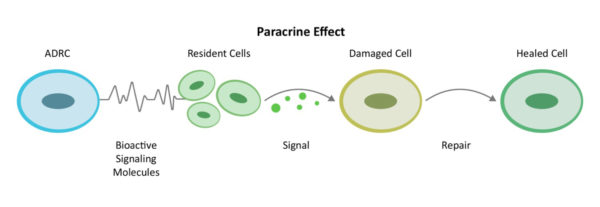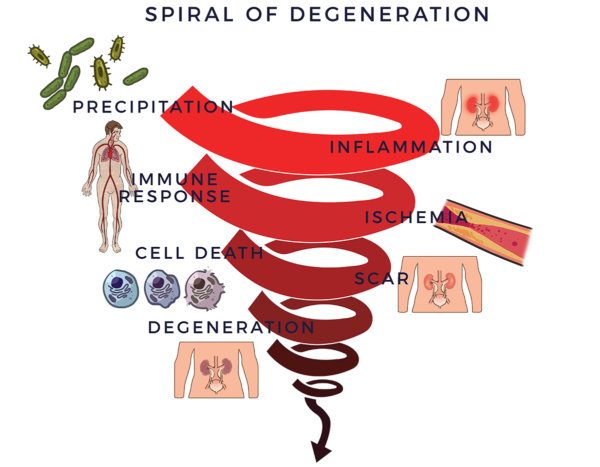Terapia cellulare AMBROSE per le malattie renali
Nel 2010, come è tipico di una nuova area di ricerca, un gruppo di scienziati ha condotto uno studio sugli animali per testare la potenziale sicurezza ed efficacia delle cellule staminali e rigenerative (ADRC) derivate dall'adipe (dal grasso) nel trattamento della malattia renale acuta.
I risultati sono stati sorprendentemente positivi, dimostrando che la terapia ADRC ha ridotto drasticamente la mortalità: 100% dei topi trattati sono sopravvissuti rispetto ai 57% che hanno ricevuto il placebo (controlli). Allo stesso modo, i topi trattati avevano livelli di creatinina sierica significativamente ridotti rispetto ai controlli.[1] Da quello studio, una serie di altri studi sulla malattia renale acuta e cronica in animali di piccola e grande taglia e nell'uomo hanno dimostrato che le cellule staminali adulte e altre cellule rigenerative provenienti dal tessuto adiposo possono potenzialmente aiutare a prevenire la progressione della malattia, abbassare i livelli di creatinina sierica, invertire la cicatrice fibrosa (fibrosi) e migliorare il flusso sanguigno.[2] [3] [4] Anche gli studi sull'uomo hanno dimostrato un miglioramento della funzione renale dopo il trattamento con cellule staminali.[5]
Cellule staminali e rigenerative di derivazione adiposa (ADRC)
Il grasso corporeo, noto come tessuto adiposo, è una fonte interessante di cellule staminali e rigenerative grazie alla sua accessibilità, abbondanza e potenza rispetto ad altre fonti di tessuto come il midollo osseo, il cordone ombelicale e la placenta. Le ADRC possono essere prelevate, trattate e reiniettate al letto del paziente con una procedura in giornata e, grazie a molteplici attività biologiche, sono state utilizzate per migliorare i sintomi, la funzionalità e la qualità della vita in un'ampia gamma di patologie, tra cui le malattie renali acute e croniche.[6] [7]
Spirale di degenerazione
Le condizioni degenerative croniche, tra cui l'insufficienza renale, seguono uno schema simile nel loro processo patologico.
Traumi, infezioni, tossine ambientali, scelte di vita non salutari (ad esempio il fumo), fattori ereditari o una combinazione di questi fattori negativi possono scatenare una risposta infiammatoria. Questo tipo di infiammazione (acuta) è essenziale per la riparazione dell'organismo e di solito è di breve durata e scompare una volta che il processo di guarigione ha avuto luogo.
Esiste un altro tipo di risposta infiammatoria persistente che diventa cronica e colpisce l'intero organismo, diventando sistemica.[8] L'infiammazione sistemica è un fattore comune nelle malattie dell'invecchiamento, che comprendono un ampio spettro di condizioni gravi, debilitanti e, talvolta, pericolose per la vita, tra cui l'insufficienza renale.[9] [10]
Nel caso delle malattie degenerative, l'infiammazione cronica avvia un processo degenerativo vizioso. Il sistema immunitario, che ha il compito di combattere le infezioni e altri processi patologici e di favorire la guarigione, viene reclutato. Le cellule del sistema immunitario (cellule immunitarie) hanno il compito di sorvegliare l'organismo. Quando percepiscono il nemico, inviano truppe di molecole pro-infiammatorie chiamate “citochine” per combatterlo. Quando questo processo va fuori controllo, si parla di risposta infiammatoria-immunitaria. Questa risposta equivale ad avere un autista posteriore che reagisce cronicamente in modo eccessivo mentre vi “aiuta” a guidare l'auto. La risposta immunitaria porta a una riduzione del flusso sanguigno (ischemia). Senza una buona circolazione, le cellule muoiono, si formano cicatrici e fibrosi, i tessuti e gli organi degenerano. Chiamiamo questa spirale di degenerazione e la usiamo come quadro di riferimento per comprendere alcuni dei fattori chiave della malattia renale.
La perdita della funzione renale corrisponde a un'infiammazione che colpisce il sistema di filtraggio dei reni e i loro piccoli vasi sanguigni. È noto che la malattia renale cronica è associata al diabete e all'ipertensione arteriosa non controllata, con un graduale peggioramento della funzione renale nel tempo. Le fasi iniziali sono solitamente prive di sintomi. La malattia renale acuta può essere rapidamente provocata da uno stato di liquidi insufficiente (dovuto a diverse condizioni) e da alcuni farmaci.
Processo di riparazione
Attraverso un meccanismo di comunicazione tra cellule noto come effetto paracrino, le ADRC mobilitano le cellule vicine a lavorare in modo più efficiente. Reclutano i vigili del fuoco, i soccorritori e i riparatori biologici del sito - le cellule staminali residenti - perché tornino al lavoro e facciano la loro parte.

Reclutando altri "riparatori" nel sito (cellule staminali residenti) per rimettersi al lavoro e fare la loro parte, le ADRC riuniscono una squadra allargata e lavorano innanzitutto per ridurre l'infiammazione e le risposte immunitarie iperattive. Una volta che la guida in retrovia diminuisce, continuano il loro lavoro aumentando la circolazione con la crescita di nuovi vasi sanguigni, prevenendo l'ulteriore morte cellulare, affrontando il tessuto cicatriziale e rigenerando i tessuti sani e i nervi. Questo è il modo in cui il corpo guarisce naturalmente, ma se l'insulto di una condizione acuta o cronica è troppo grande, ha bisogno di aiuto.
Lo chiamiamo processo di riparazione. Si tratta dei molteplici meccanismi d'azione necessari per riportare in equilibrio l'infiammazione sistemica e la risposta immunitaria.
Terapia cellulare AMBROSE per le malattie renali
Poiché i fattori primari della spirale di cui sopra sono coinvolti nell'insufficienza renale e i meccanismi di riparazione multipla delle ADRC hanno dimostrato di invertire tali effetti in questa condizione e in una serie di altre patologie gravi, i pazienti con malattie renali possono potenzialmente trarre beneficio dalla terapia cellulare AMBROSE.
Gli studi sugli animali hanno dimostrato che le cellule staminali riducono le lesioni renali acute attivando globuli bianchi specializzati che avviano la guarigione e la riparazione del tessuto renale e proteggono dall'invecchiamento cellulare prematuro.[11] [12] [13]
Allo stesso modo, è stato dimostrato che il trattamento con cellule staminali della malattia renale cronica negli animali promuove il recupero della produzione di energia delle cellule renali.[14] [15], ridurre le cicatrici[16], e diminuire l'infiammazione.[17]
La terapia cellulare AMBROSE rappresenta un'opzione di trattamento minimamente invasiva per i pazienti affetti da malattie renali. Contattateci per avere maggiori informazioni sul trattamento, sulla candidatura e su come diventare un paziente.
[1] Z Feng et al Cellule staminali e rigenerative derivate dal tessuto adiposo, fresche e crioconservate, non coltivate, migliorano il danno renale acuto indotto da ischemia-riperfusione, Nefrologia Dialisi Trapianto, Volume 25, Numero 12, 1 dicembre 2010, Pagine 3874-3884
[2] C Donizetti-Oliveira Il trattamento con cellule staminali derivate dal tessuto adiposo previene la progressione della malattia renale Cell Transplantation, Vol. 21, pp. 1727-1741, 2012
[3] A Eirin et al Le cellule staminali mesenchimali derivate dal tessuto adiposo migliorano i risultati della rivascolarizzazione per ripristinare la funzione renale nella stenosi aterosclerotica dell'arteria renale dei suini Stem Cells. 2012 maggio; 30(5): 1030-1041
[4] JJ Rivera-Valdés et al. (2017) Le cellule staminali derivate dall'adipe umano regrediscono la fibrosi in un modello fibrotico renale cronico indotto dall'adenina. PLoS ONE 12(12)
[5] El-Ansary M, Saadi G, Abd El-Hamid SM. Le cellule staminali mesenchimali sono un approccio di salvataggio per il recupero della funzione renale in deterioramento. Nefrologia 2012;17:650-657.
[6] Guo et al Frazione vascolare stromale: Una realtà rigenerativa? Parte 2: concetti attuali e revisione della letteratura Journal of Plastic, Reconstructive & Aesthetic Surgery (2016) 69, 180e188
[7] JK Fraser PhD e S Kesten MD Cellule rigenerative di derivazione adiposa autologhe: Una piattaforma per applicazioni terapeutiche Advanced Wound Healing Surgical Technology International XXIX
[8] S. Amor L'infiammazione nelle malattie neurodegenerative Immunologia, 129, 154-169
[9] C. Franceschi e J. Campisi L'infiammazione cronica (Inflammaging) e il suo potenziale contributo alle malattie associate all'età J Gerontol A Biol Sci Med Sci 2014 June;69(S1): S4-S9
[10] Suliman ME, Stenvinkel P. Contributo dell'infiammazione alla malattia vascolare nei pazienti con malattia renale cronica. Saudi J Kidney Dis Transpl 2008;19:329-45
[11] Geng, Y.; Zhang, L.; Fu, B.; Zhang, J.; Hong, Q.; Hu, J.; Li, D.; Luo, C.; Cui, S.; Zhu, F.; et al. Le cellule staminali mesenchimali migliorano il danno renale acuto indotto dalla rabdomiolisi attraverso l'attivazione dei macrofagi m2. Stem Cell Res. Ther. 2014, 5, 80
[12] Lee, S.J.; Ryu, M.O.; Seo, M.S.; Park, S.B.; Ahn, J.O.; Han, S.M.; Kang, K.S.; Bhang, D.H.; Youn, H.Y. Le cellule staminali mesenchimali contribuiscono al miglioramento della funzione renale in un modello di danno renale canino. In Vivo 2017, 31, 1115-1124
[13] Rodrigues, C.E.; Capcha, J.M.; de Braganca, A.C.; Sanches, T.R.; Gouveia, P.Q.; de Oliveira, P.A.; Malheiros, D.M.; Volpini, R.A.; Santinho, M.A.; Santana, B.A.; et al. Le cellule mesenchimali stromali derivate dal cordone ombelicale umano proteggono dalla senescenza renale prematura causata dallo stress ossidativo nei ratti con lesioni renali acute. Stem Cell Res. Ther. 2017, 8, 19
[14] Yoon, Y.M.; Han, Y.S.; Yun, C.W.; Lee, J.H.; Kim, R.; Lee, S.H. Pioglitazone protegge le cellule staminali mesenchimali dalla disfunzione mitocondriale indotta dal p-cresolo attraverso l'up-regulation di pink-1. Int. J. Mol. Sci. 2018, 19, 2898
[15] Lira, R.; Oliveira, M.; Martins, M.; Silva, C.; Carvalho, S.; Stumbo, A.C.; Cortez, E.; Verdoorn, K.; Einicker-Lamas, M.; Thole, A.; et al. Il trapianto di mscs derivate dal midollo osseo migliora la funzione renale e l'attività della na(+)+k(+)-atpasi in ratti con ipertensione renovascolare. Cell Tissue Res. 2017, 369, 287-301
[16] Wu, H.J.; Yiu, W.H.; Li, R.X.; Wong, D.W.; Leung, J.C.; Chan, L.Y.; Zhang, Y.; Lian, Q.; Lin, M.; Tse, H.F.; et al. Le cellule staminali mesenchimali modulano l'infiammazione e la fibrosi tubulare renale indotta dall'albumina. PLoS ONE 2014, 9, e90883
[17] Abdel Aziz, M.T.; Wassef, M.A.; Ahmed, H.H.; Rashed, L.; Mahfouz, S.; Aly, M.I.; Hussein, R.E.; Abdelaziz, M. Il ruolo delle cellule staminali mesenchimali derivate dal midollo osseo nell'attenuazione della funzione renale nei ratti con nefropatia diabetica. Diabetol. Metab. Syndr. 2014, 6, 34



